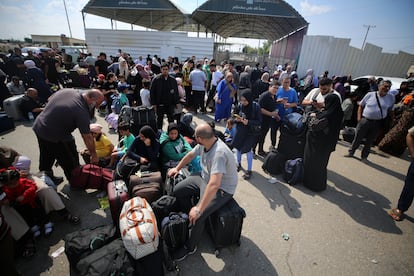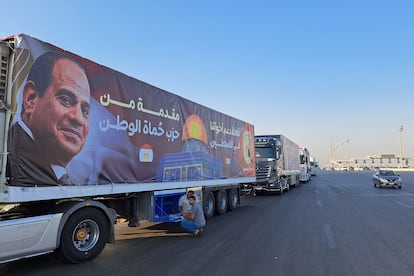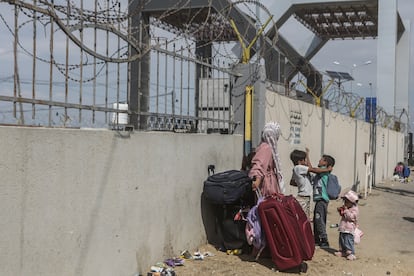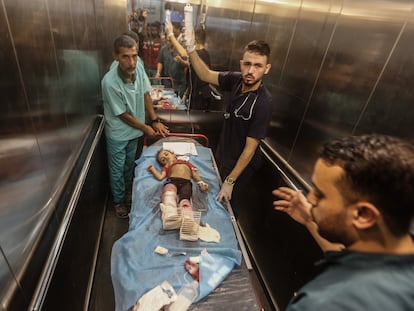Exodus from Gaza and international aid place Rafah crossing at the epicenter of Israel-Hamas conflict
The border crossing with Egypt is the only one not controlled by Israel, which has bombed it at least three times. Cairo fears a huge influx of refugees and wants security guarantees to reopen it for humanitarian access

The intense aerial bombardment and the “complete siege” policy launched by Israel on Gaza after the armed wing of the Palestinian movement Hamas launched an attack on Israeli territory on October 7 has turned a remote spot in Egypt’s Sinai Peninsula into the center of global attention. The Rafah border crossing, located in southern Gaza, directly connects Gaza to Egypt and is the only entry and exit point not controlled by Israel, making it the sole route through which the Israeli blockade of the Palestinian enclave can be bypassed and emergency humanitarian aid sent to the more than two million civilians trapped there.
Early last week, Israel shelled the Palestinian terminal of the crossing three times in 24 hours, disrupting its normal operation. Since then, Egypt has been negotiating with Israel, the U.S., the U.N. and Qatar for Benjamin Netanyahu’s government to provide security guarantees for its reopening to deliver humanitarian assistance. Under normal conditions, the Rafah crossing is administered by Cairo and Hamas Interior Ministry officials, but it is mainly the Egyptian and Israeli authorities that exercise strictest control over the movement of people and goods.

The crossing is of great concern to Egyptian President Abdel Fattah El-Sisi, who fears a massive exodus of Palestinian refugees fleeing the bombings and the land invasion that Israel, according to his government, is preparing imminently. Additionally, on the Palestinian side of the crossing, there are hundreds of Gazans and citizens of third countries, especially Americans, waiting for the border to open so that they can leave the enclave.
In an attempt to press for its opening, and to be prepared in case an agreement is finally forged, Egypt last week prepared the airport in the capital of North Sinai province, Al Arish, around 50 kilometers (31 miles) from Rafah, to receive international humanitarian aid shipments. Countries such as Jordan, Turkey and the United Arab Emirates, as well as organizations including as the Red Crescent and the World Health Organization (WHO), have already sent hundreds of tons of basic necessities destined for Gaza. But for now, dozens of truckloads of supplies, carrying mainly food, water and medicine, remain stuck on the Egyptian side of the border waiting for the green light to cross.
What role Israeli officials would have in the mechanism governing the delivery of humanitarian aid to Gaza remains unclear. The Sinai Foundation for Human Rights said Monday that Israel’s insistence on inspecting all trucks before they enter Gaza was at least one of the reasons its implementation initially failed. The plan that has been put forward so far involves approving a geographically delimited ceasefire zone inside Gaza so that aid arriving in the enclave can be distributed. Cairo has stated that it will only allow the exit of foreigners residing in the enclave if at the same time trucks are allowed to enter.
Movement through the Rafah crossing — which was opened in 1982 after Israel withdrew from Sinai as part of the peace agreement it signed with Egypt three years earlier — has fluctuated greatly over the past decade depending on the political context; it remains a sensitive issue for the Egyptian authorities, not least because of the presence of Hamas. Between mid-2012 and 2013, coinciding with the presidency in Egypt of Mohamed Morsi of the Muslim Brotherhood — which shares the ideology of Hamas — the crossing was open for 341 days and recorded intense activity, according to U.N. data. In contrast, between 2014 and 2017, coinciding with staunch Brotherhood opponent El-Sisi’s first years in power, Rafah remained closed for almost 300 days a year on average. The situation only started to improve from May 2018 onwards, at a time when Gaza was undergoing a serious humanitarian and political crisis.
Since then, the Rafah crossing has operated more regularly, with the exception of closures imposed by the Covid-19 pandemic. Despite this, the criteria imposed by Egypt for people wishing to travel through the crossing remain strict and the waiting time for processing the permit is often lengthy, according to the Israeli human rights organization Gisha, which monitors freedom of movement for Palestinians. Israel, for its part, often prohibits people leaving Gaza through Rafah from re-entering through the Erez crossing between the Strip and Israel, which presents an added obstacle.
In addition, the vast, desert-like northern Sinai, separated from the rest of Egypt by the Suez Canal, is a completely militarized region and access is severely restricted, even for the press. Egypt has been waging a bitter war in the province for years against the local branch of Islamic State, which has recruited many Gazan members and whose momentum has only been slowed over the last three years by an extensive joint counter-terrorism campaign waged by the Egyptian army and security forces and their tribal allies.

Sign up for our weekly newsletter to get more English-language news coverage from EL PAÍS USA Edition
Tu suscripción se está usando en otro dispositivo
¿Quieres añadir otro usuario a tu suscripción?
Si continúas leyendo en este dispositivo, no se podrá leer en el otro.
FlechaTu suscripción se está usando en otro dispositivo y solo puedes acceder a EL PAÍS desde un dispositivo a la vez.
Si quieres compartir tu cuenta, cambia tu suscripción a la modalidad Premium, así podrás añadir otro usuario. Cada uno accederá con su propia cuenta de email, lo que os permitirá personalizar vuestra experiencia en EL PAÍS.
¿Tienes una suscripción de empresa? Accede aquí para contratar más cuentas.
En el caso de no saber quién está usando tu cuenta, te recomendamos cambiar tu contraseña aquí.
Si decides continuar compartiendo tu cuenta, este mensaje se mostrará en tu dispositivo y en el de la otra persona que está usando tu cuenta de forma indefinida, afectando a tu experiencia de lectura. Puedes consultar aquí los términos y condiciones de la suscripción digital.
More information
Archived In
Últimas noticias
Welcome to the post-religion era: The idea of Christianity as the absolute truth has become obsolete
‘I thought you would like it’: The risky sexual practice popularized by TV shows and TikTok
The digitalization of tourism: ‘They promise experiences and gave us the worst possible one’
Mexican peso defies uncertainty with forecasts of a new period of stability in 2026
Most viewed
- Sinaloa Cartel war is taking its toll on Los Chapitos
- Reinhard Genzel, Nobel laureate in physics: ‘One-minute videos will never give you the truth’
- Oona Chaplin: ‘I told James Cameron that I was living in a treehouse and starting a permaculture project with a friend’
- Why the price of coffee has skyrocketed: from Brazilian plantations to specialty coffee houses
- Silver prices are going crazy: This is what’s fueling the rally











































